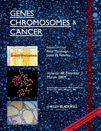Gene position within chromosome territories correlates with their involvement in distinct rearrangement types in thyroid cancer cells
Abstract
Chromosomal rearrangements in human cancers are of two types, interchromosomal, which are rearrangements that involve exchange between loci located on different chromosomes, and intrachromosomal, which are rearrangements that involve loci located on the same chromosome. The type of rearrangement that typically activates a specific oncogene may be influenced by its nuclear location and that of its partner. In interphase nuclei, each chromosome occupies a distinct three-dimensional (3D) territory that tends to not overlap the territories of other chromosomes. It is also known that after double strand breaks in the genome, mobility of free DNA ends is limited. These considerations suggest that loci located deep within a chromosomal territory might not participate in interchromosomal rearrangements as readily as in intrachromosomal rearrangements. To test this hypothesis, we used fluorescence in situ hybridization with 3D high-resolution confocal microscopy to analyze the positions of six oncogenes known to be activated by recombination in human cancer cells. We found that loci involved in interchromosomal rearrangements were located closer to the periphery of chromosome territories as compared with the loci that were involved in intrachromosomal inversions. The results of this study provide evidence suggesting that nuclear architecture and location of specific genetic loci within chromosome territories may influence their participation in intrachromosomal or interchromosomal rearrangements in human thyroid cells. © 2008 Wiley-Liss, Inc.




